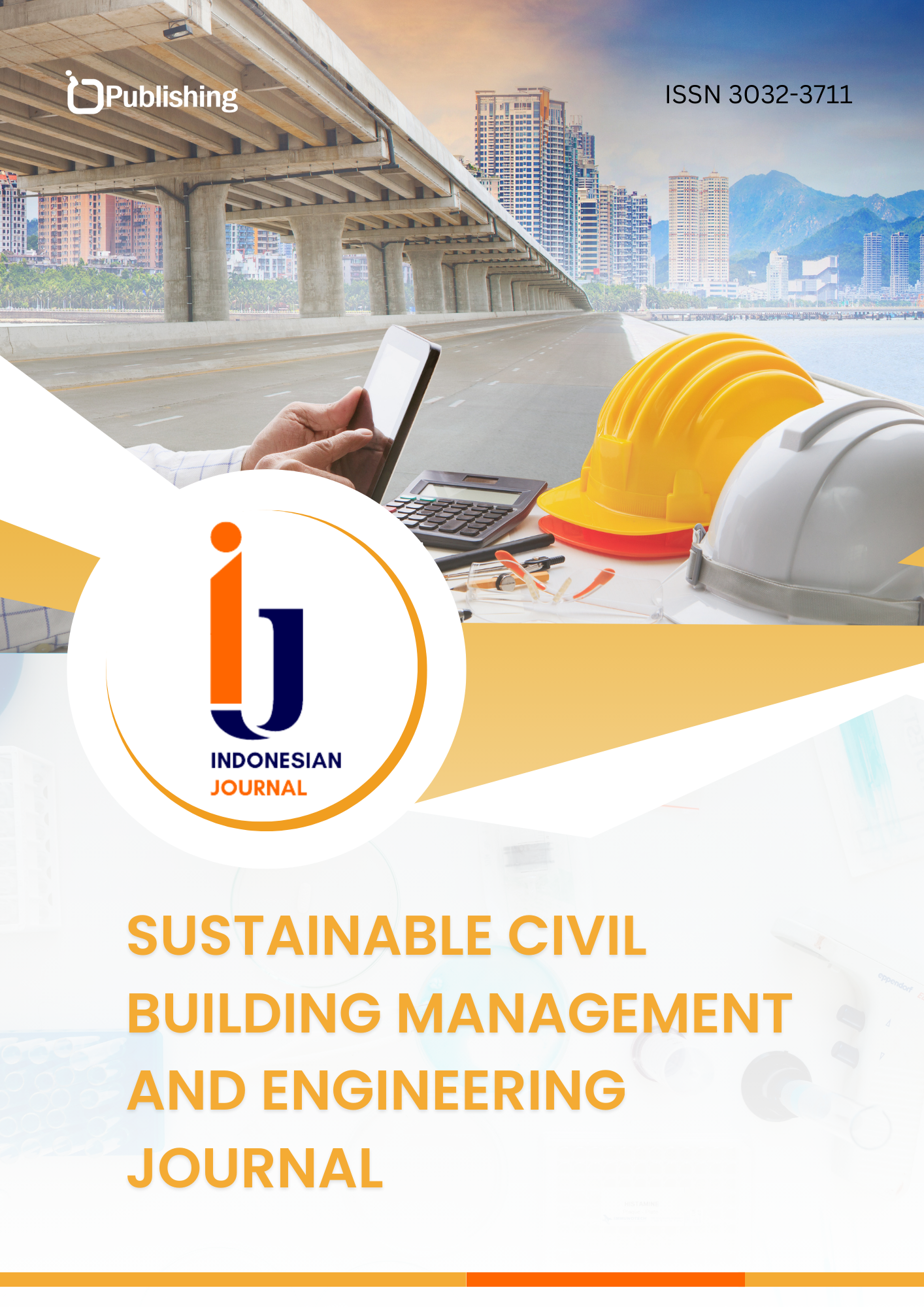Development of Measures to Reduce Air Pollutants As Much As Possible
DOI:
https://doi.org/10.47134/scbmej.v1i2.2400Keywords:
Atmosphere, Earth's Surface, Permissible Levels, Chemical Substances, Harmful Elements, Organisms, Sanitary Norms and Rules (SanN.R.)Abstract
The papers include contemporary ecological challenges, steps taken to reduce artificial pollution, and environmental issues relating to the atmosphere's circulation through natural and artificial processes. A major threat to world health, air pollution can have a range of negative consequences on the environment, such as haze, eutrophication, acid rain, and harm to animals. The combustion of fossil fuels for energy production and transportation is the main cause of air pollution. The effects of air pollution on human health are significant, with millions of people affected by respiratory and cardiovascular diseases, reproductive and central nervous system dysfunctions, and cancer. The articles emphasize the importance of reducing air pollution through various measures, such as improving energy efficiency, promoting renewable energy sources, reducing emissions from transportation, and implementing policies and regulations to control air pollution. The articles also highlight the need for public awareness and a multidisciplinary approach to tackle the problem of air pollution and its impact on climate change and public health.
References
Alimov, Т. A., & Rafikov, A. A. (1991). Ekologiya xatolik saboqlari. O’zbekiston.
Asha, P. (2022). IoT enabled environmental toxicology for air pollution monitoring using AI techniques. Environmental Research, 205. https://doi.org/10.1016/j.envres.2021.112574 DOI: https://doi.org/10.1016/j.envres.2021.112574
Baratov, P. (1991). Тabiatni muhofaza qilish. O’qituvchi.
Gómez-Sanabria, A. (2022). Potential for future reductions of global GHG and air pollutants from circular waste management systems. Nature Communications, 13(1). https://doi.org/10.1038/s41467-021-27624-7 DOI: https://doi.org/10.1038/s41467-021-27624-7
Hill, W. (2023). Lung adenocarcinoma promotion by air pollutants. Nature, 616(7955), 159–167. https://doi.org/10.1038/s41586-023-05874-3 DOI: https://doi.org/10.1038/s41586-023-05874-3
Hoang, H. G. (2022). The nitrogen cycle and mitigation strategies for nitrogen loss during organic waste composting: A review. Chemosphere, 300. https://doi.org/10.1016/j.chemosphere.2022.134514 DOI: https://doi.org/10.1016/j.chemosphere.2022.134514
Ismayilov, K., Suleymanov, S. T., Ruziev, S. T., & Aripjanova, M. B. (2020). A new method of successive approximations when calculating elements of electromechanical machines. XXI Century. Technosphere Safety, 5(2), 168–172. DOI: https://doi.org/10.21285/2500-1582-2020-2-168-172
Ismaylov, K., Suleymanov, A., Toshev, S., & Ruziev, S. (2021). Option Of The Method Of Successive Approximations In Calculating The Epicenters Of Extreme And Emergency Situations. Ilkogretim Online, 20(3). DOI: https://doi.org/10.17051/ilkonline.2021.03.186
Khomenko, S. (2021). Premature mortality due to air pollution in European cities: a health impact assessment. The Lancet Planetary Health, 5(3). https://doi.org/10.1016/S2542-5196(20)30272-2 DOI: https://doi.org/10.1016/S2542-5196(20)30272-2
Leung, S. C. E. (2022). Emerging technologies for PFOS/PFOA degradation and removal: A review. Science of the Total Environment, 827. https://doi.org/10.1016/j.scitotenv.2022.153669 DOI: https://doi.org/10.1016/j.scitotenv.2022.153669
Mohsenpour, S. F. (2021). Integrating micro-algae into wastewater treatment: A review. Science of the Total Environment, 752. https://doi.org/10.1016/j.scitotenv.2020.142168 DOI: https://doi.org/10.1016/j.scitotenv.2020.142168
Munir, N. (2022). Heavy metal contamination of natural foods is a serious health issue: A review. Sustainability (Switzerland), 14(1). https://doi.org/10.3390/su14010161 DOI: https://doi.org/10.3390/su14010161
Murugesan, P. (2022). Role of hydrogen in improving performance and emission characteristics of homogeneous charge compression ignition engine fueled with graphite oxide nanoparticle-added microalgae biodiesel/diesel blends. International Journal of Hydrogen Energy, 47(88), 37617–37634. https://doi.org/10.1016/j.ijhydene.2021.08.107 DOI: https://doi.org/10.1016/j.ijhydene.2021.08.107
Perera, F. (2022). Climate Change, Fossil-Fuel Pollution, and Children’s Health. New England Journal of Medicine, 386(24), 2303–2314. https://doi.org/10.1056/NEJMra2117706 DOI: https://doi.org/10.1056/NEJMra2117706
Ruziev, S., & Suleymanov, A. (2020). Harbiylashtirilgan obyektlarida favqulodda vaziyatlarni bartaraf etish. GlobeEdit.
Ruziev, S. T. (2022). Determination of additional aspiration flows produced in the fire zone in field conditions with solutions. Central Asian Journal of Theoretical and Applied Science, 3(6), 101–104.
Ruziev, S. T., & Achilov, A. M. (2023). Chet Davlatlarda Aholini Favqulodda Vaziyatlarda Ogohlantirish, Xabar Berish Usullarini O‘Rganish Va Tahlil Qilish. Miasto Przyszłości, 40, 464–467.
Ruziev, S. T., M., A. A., & Sh., K. M. (2022). The Role and Importance of Training and Tactical Training in Higher Education in Reducing Fire Risk. European Journal of Life Safety and Stability (2660-9630), 208–211. https://www.ejlss.indexedresearch.org/index.php/ejlss/article/view/396
Ruziev, S. T., & Sultonov, R. (2023). EXPERIMENTAL TAKIKOTLAR ASOSIDA ZAMONAVIY ASBOBLAR VA USKUNALARDAN FOYDALANILGAN XOLDA KOSHIMCHA ASPIRATION OKIMLARNI ANIKLASH. Gospodarka va Innovacje, 36, 208–213.
Ruziyev, S., & others. (2023). Determination Of The Additional Aspiration Coefficient Formed In The Combustion Zone. Excellencia: International Multi-Disciplinary Journal of Education (2994-9521), 59–68.
Southerland, V. A. (2022). Global urban temporal trends in fine particulate matter (PM2·5) and attributable health burdens: estimates from global datasets. The Lancet Planetary Health, 6(2). https://doi.org/10.1016/S2542-5196(21)00350-8 DOI: https://doi.org/10.1016/S2542-5196(21)00350-8
Su, C. W. (2022). Can green credit reduce the emissions of pollutants? Economic Analysis and Policy, 74, 205–219. https://doi.org/10.1016/j.eap.2022.01.016 DOI: https://doi.org/10.1016/j.eap.2022.01.016
Suleymanov, A. A., & others. (2023). EVACUATION OF THE POPULATION IN CASE OF THREAT AND EMERGENCY SITUATIONS. JOURNAL OF ENGINEERING, MECHANICS AND MODERN ARCHITECTURE, 67–72.
Suleymanov, A. A., Ruziev, S. T., & Karimov, B. G. (n.d.). Localization Of Emergency Situations Using Aspiration Flow Coefficiency. JournalNX.
Sun, Y. (2022). Role of green finance policy in renewable energy deployment for carbon neutrality: Evidence from China. Renewable Energy, 197, 643–653. https://doi.org/10.1016/j.renene.2022.07.164 DOI: https://doi.org/10.1016/j.renene.2022.07.164
Toirovich, R. S., Yasakov, Z. X., & Achilov, A. M. (2023). Early Calculation of Forces and Means to Reduce the Risk of Emergencies (Fires). International Journal on Orange Technologies, 5(12), 67–72.
Downloads
Published
How to Cite
Issue
Section
License
Copyright (c) 2024 Sukhrob Ruziyev, Hamraqulova Hamraqulova, Rustamova R.A., Tolibova D.M.

This work is licensed under a Creative Commons Attribution 4.0 International License.










